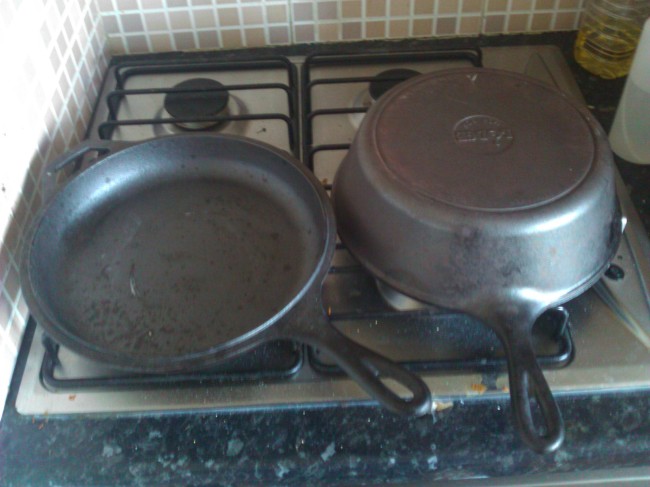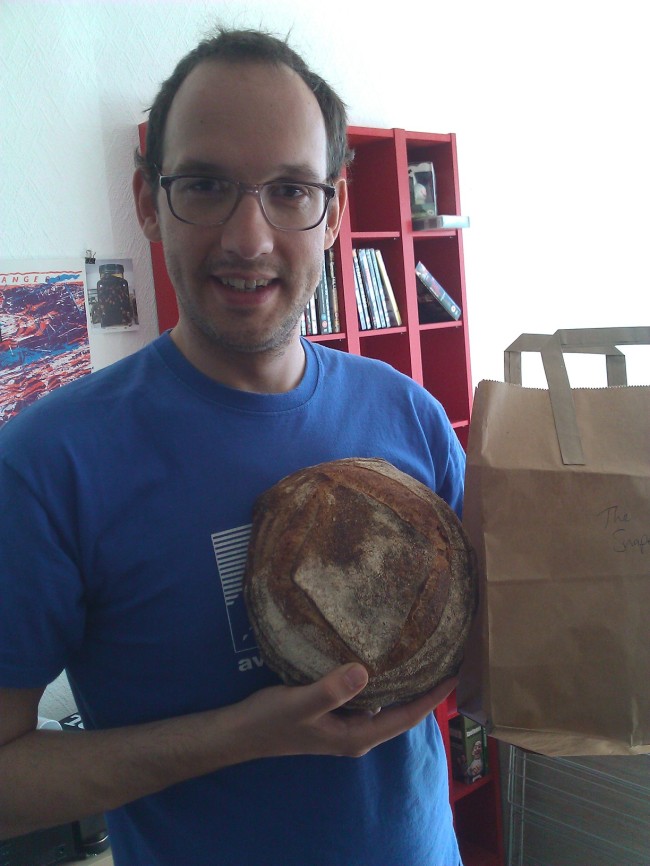Good afternoon world!
If you’ve been following my rebirth as a baker, you will know that I’ve been on a hunt for my basic sourdough loaf recipe (see ‘Finding my bread’). Well, the recipe quantities have stayed the same, but as anyone who bakes a lot of bread will know, it’s the flour that’s the important thing. At the weekend I went through the vast selection of flour that I had delivered.
I went for a traditional organic flour from Shipton Mill, with a bit of of organic whole wheat flour also from Shipton Mill. Both are an ancient variety of wheat called Maris Widgeon (used traditionally for thatching roof tops). As soon as I mixed it i knew it was going to be good. I think that when people see me mixing with my hand rather than some kitchen utensil they think ‘whats the point? he’s got sticky dough all over his hands. Idiot!’. Well, to those people I would say ‘shut up drylords!’. You get to know what a good dough feels like, and you remember. Which means when you’ve nailed it, you’ll nail it every time. Making bread is all about using your senses, intuition and common sense, taking key factors into account: temperature of the water, the flour, the air, and the humidity. Anyway, I’m not going to get too in depth now. Back to it!…The dough was promising and smelt like harvest time in Piddington (my home village). This is what I’d been looking for. After it’s first prove I divided and shaped, then tucked these three into their proving beds for a nice sleep, and in the morning they looked so ready to get up and into that oven.
At home, I bake in a dutch oven…Lads, I can hear you laughing from here you sad bastards! What are you like 12?! Get over it! This is a dutch oven combo cooker:
You turn your proved loaf into the preheated shallow skillet, slash the top, and cover with the deep pan, into the oven and remove after 20 mins. Bake until dark ember. Coving the loaf is basically steaming it. This is what makes it rise properly. It’s this kind of atmosphere that is created in a professional bread oven.
I loaded the first one with hope. The anticipation I get from the first 20 minutes when the loaf is covered is almost unbearable. Will it be tall and proud with a great burst? Will it be a pathetic flat discus? Testing is stressful! This time ladies and gentlemen, they were a thing of glory. Look!:
The look, the smell, the crust were all where I wanted them. I think I’ve done it. I think The Field Loaf is in existence.
When I realised all was good, I took it to the internet. FREE BREAD! Here are the two excellent recipients:
The Snapery’s first delivery.
Winner!
Baxter is a bread lover. Laura is my FIRST paying customer! The Snapery is in business!
…A correctly presented loaf.
So there you go. I got me bread. Obviously there will be tweaks, it can always be better, but I am happy with what I produced on Sunday. So this Sunday coming, I’ll be making more, and doing the same. More FREE BREAD!…Unless you’re like Laura and force money in my hand. In which case I’ll initially protest but inevitably give in because it’s easier that way.
Everybody, have a excellent day!
Love RPS. x










Hey,
I was just wondering if you had any advice for beginning a sourdough starter. I know which flour I will be using, Calbourne Mill Organic Stoneground, but I’m undecided about using yeast and if so which sort, or chucking a few raisins/grapes in and seeing what happens.
Thanks
Hey there!
The starter I have is a first attempt, and i’ve had it going now for nearly 2 years. So, mine is half white flour, half whole wheat flour. What I did was same amount of flour (200g) and water (200g), apple peel, table spoon of yoghurt, table spoon of honey leave covered with a wet tea towl in a warm place for 48 hours. By this time it should show signs of activity, slightly bubbly. If it isn’t leave it longer another 12 hours. A lot of people think it isn’t working and throw away. Don’t do that. eventually it will work. at the sign of activity, remove the peel (if you used it) scrape off any dryness you may have, and feed with same amounts of the flour (100 -200g) and water, leave for another 24 hours covered in a warm place. If by this point it is looking quite bubbly, you have a culture going! now, you have quite a volume, so you need to discard half, and feed with flour and water equal to the amount of the sourdough left over. Keep discarding and feeding daily for a few days. After this it should be ready to make bread with. At which point it should be very stable and reliable. When you feed after this point you can discard 3/4 of the starter and feed with equal amounts of flour and water.
To be honest, every starter is different. Because it is a living thing that likes warmth, if you’re in a climate where it is hot, you may need to feed it twice a day. unless you refrigerate. I don’t like to refrigerate as it’s difficult to know whats going on with it, if it is happy or not. What a sourdough culture really likes is routine, if you find it’s routine for your climate, it wont let you down. You must treat it like a living thing, like a pet. Well, you don’t have too, but it might die if you dont. Saying that, if you forget to feed it one day, it will forgive you if you feed it. I hope that helps. Although i’m happy with mine, I strongly suggest you get this book:
It’s amazing.
Anyway… I went on a bit. Let me know how it goes.
Thanks for the message!
Richard.
Hi,
Thank you very much for taking the time to reply. I hadn’t considered that approach to making a starter before but it certainly sounds like a method I would enjoy. Just pouring some fast action yeast in just didn’t seem right to me, so once I’ve stocked up on flour I shall definitely follow your advice. And I shall definitely add that book to my wishlist.
Thanks again,
Chris
Reblogged this on thesnapery.
No problem. Hope it goes well.